by Carolyn Edlund
Two artists use very different methods to have their artwork placed on fabric, allowing them to expand their collections into wearables and other products. Here’s how they did it.
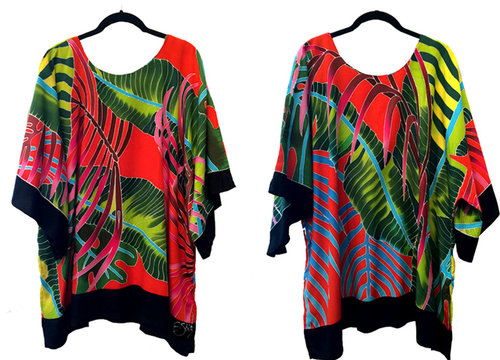
“Fiery Palms” handpainted top from a design by Eileen Seitz
Ever wish you could leverage your paintings or 2D art by transforming your designs into a variety of products for sale? Artists often use Print-on-Demand providers to sell their art on clothing, pillows and other items, but that only creates a small stream of income. POD providers do most of the work, so they keep the lion’s share of the price. But there are other solutions to creating art on fabric that can give you the opportunity to sell increase sales by offering a wider line of products.
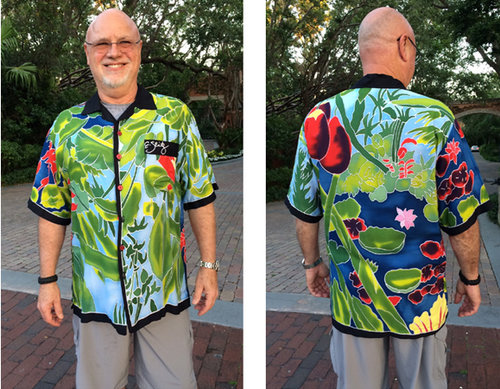
Handpainted shirt in “Dripping Mangos” design created from original art by Eileen Seitz
Eileen Seitz
Painter Eileen Seitz shares her experience, saying “I have always made my own clothes, and dreamed of designing textiles for interior furnishings and clothing. A very good friend of mine knew this about me, and has friends overseas that have a studio. While on one of his trips, he emailed, asking me to send images of textile designs I would like for them to make for me as samples. After having them in my hands upon his return, I placed my orders.”
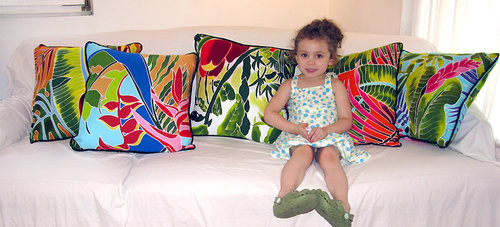
Eileen Seitz’s line also includes handpainted pillows.
Turning over designs to another studio involves trust and a willingness to allow your work to be interpreted by others. She explains, “I am at the hands of other painters that hand paint the liquid medium onto the fabric with a sponge. Even though I went to the studio, it is a process. I did not have the time or practice to do it myself. Hence, I cannot control the final color blends. Each fabric design is one of a kind, a unique piece of artwork. They are not printed, not consistent, like on plates and presses. I have to accept this part of the process. I’m also limited to the size of the cut piece of fabric 48” x 72”. And I cannot buy a 200 yard bolt of it, so again I am limited.
Despite challenges, Seitz has been successful selling her work as wearable art and accessories. How does she do it?
“I sell my clothing, pillows, fabrics at art shows, in my gallery and on my website,” the artist says. “Once I wore my hand painted camisole visiting a friend. Her friend asked me about my camisole. After trying it on with my magenta leggings, she bought both right off my back!”
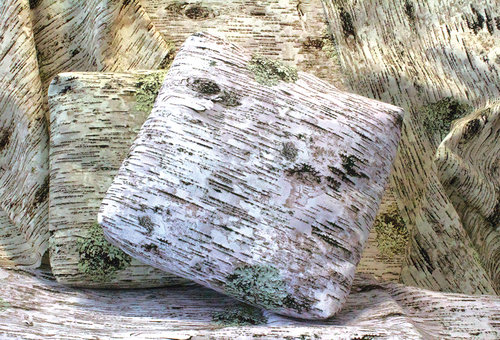
Savoy Birch fabric and pillows by Martha Flood
Martha Flood
Artist Martha Flood also focuses on fabric, but comes from a different background. She says, “I’m a textile designer. I first got into digital printing about ten years ago when I showed a portfolio at a design trade show in New York City. In preparation, I printed two patterns on fabric and used them as the backdrop of my booth. It was so much fun seeing my artwork as fabric – I was hooked.”
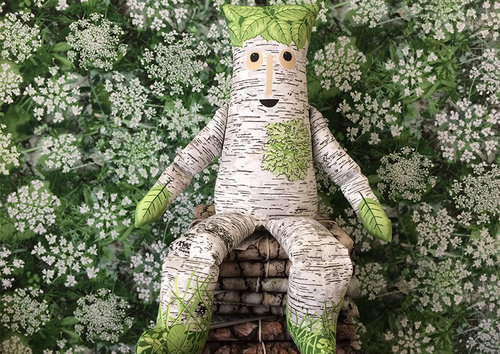
Birch sapling doll by Martha Flood
Flood uses a variety of methods to create artwork including photography, drawing and computer graphics, making repeat patterns and carefully choosing the colors. Her final artwork is in a digital format that can be printed by industry textile printers. Using on-demand services for experimentation and small runs, she taps the services of an industry printer for larger runs on a fabric that she provides. Once the fabrics are printed, the artist does all the sewing of pillows, bags, placemats, banners, shades and custom projects in her studio.
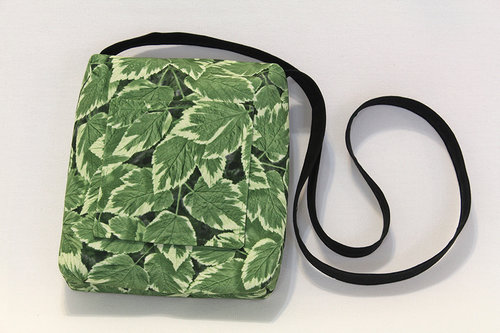
Handmade bag using custom fabric designed by Martha Flood.
Printing on fabric is a process that differs considerably from printing on paper. The artist explains, “It’s critical to understand the difference. Artwork that will look crisp and varied on paper may look flat and dull on fabric. In general, artwork needs to have greater contrast between light and dark tones. Also, colors may shift in hue when printed. I manage these problems by printing a hue, saturation and value color chart on fabric. Then I can compare my paper prints with the fabric prints.”
Floods sells her handmade work through brick and mortar storefronts as well as on her website and an Etsy shop.
Both of these artists have developed solutions for creating fabrics using their designs that brings them a larger return than print-on-demand, as well as more control over their businesses.


Hi everyone at Artsy Shark and everyone reading this article. We are a small family-owned business, and have just launched a very platform dedicated to this cause! It is our mission to bring together our love for natural and quality fibres and artists who would love to transform their work into wearable pieces or homewares. Our website will be live soon, but meanwhile you can follow us on our Instagram page. If you are, or know of, an artist looking for some guidance and support on this new journey – check us out ♡ @nicocodesign_ Love from our families to yours!